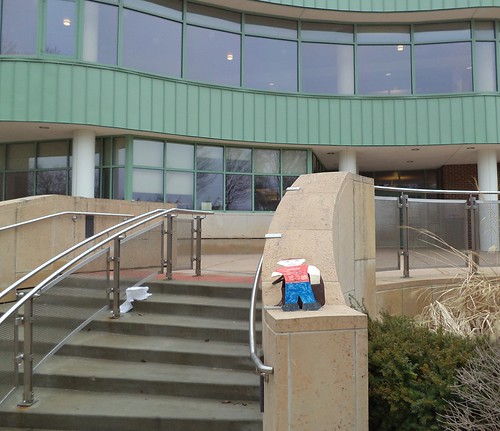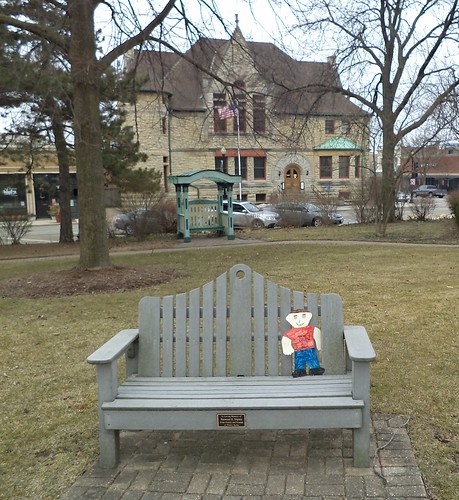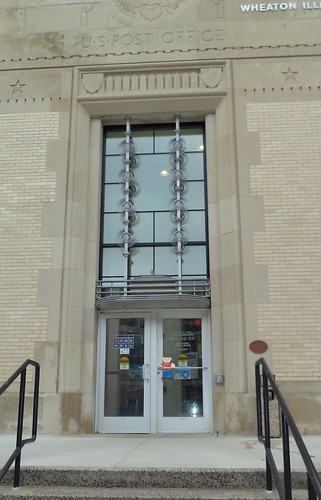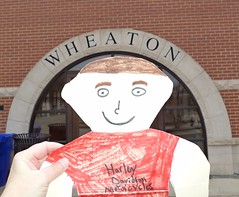One of the last things I did with Flat Stanley was take him around Wheaton, where I've lived for over 30 years.
We started at Adams Park. It's a large park just to the north of downtown. It used to be framed by streets but several years ago, the library got the eastern street vacated and they expanded, building an entrance accessible from the park.
I haven't been in the new addition since it opened. I used to use the library all the time. I knew several of the librarians, but I've found that my need for what they offer is, currently, non existant. That might be a reflection on society in general as people can find things they used to go to the library for, online. Libraries should never go away and I'll generally always vote for a library referendum, unlike some other tax increases. If you're interested, go here and watch the video about the Troy, Michigan library's funding campaign. Inspired.
After we went to the library building, we went into Adams Park, itself. The park is built on the site of the home of one of Chicago's prominent merchants, John Quincy Adams, a 4th cousin of the 6th president. In the center of the park is a fountain. It was covered for the winter.
Turning to our right, we can see the DuPage Historical Museum.
This limestone structure was, originally, the Wheaton Memorial Library, and was built in honor of Adams' wife. Wheaton and Downer's Grove were the only DuPage towns to have a public library at the end of the 19th century. In 1967, the current library was built and the historical society moved in.
From there, we went to other important places in Wheaton. We stopped by the post office.
This building is on the National Register of Historic Places. It was build in 1933, during the Great Depression and is classified as a Works Progress building. The interior has changed quite a bit since I moved here but the exterior has been lovingly preserved.
Across the street from the post office is city hall.
One of Chicago's claims to fame was being the railroad hub of the US. If you wanted to get freight from the west to the east or the east to the west with any speed, you had to route it through Chicago. Part of that legacy goes through Wheaton. It started with the Galena and Western in the post Civil War years and continues with the Union Pacific today.
The other facet of railroad life is the need to move people. In the late 19th Century, this concept was seen with some now suburban towns being viewed as vacation destinations. Glen Ellyn, the town immediately to my east, has a lake just off their downtown. Chicagoans would take the train to Glen Ellyn to spend vacations at the large hotels that sprang up around Lake Ellyn. An electrified railroad, the Chicago, Aurora and Elgin, ran from Franklin Park to the western cities of Aurora and Elgin. This was an early commuter railroad. When it folded, the right of way from Melrose Park to Aurora and Elgin was given to a non-profit and turned into the Illinois Prairie Path.
As Chicago grew, the need to get people from the growing suburban community to their jobs in the city caused the railroads to add commuter service. Each railroad had its own service, but by the 1970's, they all wanted to abandon passenger service. It just wasn't making any money. The Illinois legislature created the Regional Transportation Authority, which became the Commuter Rail Service Board which became Metropolitan Rail or Metra, in 1987. It is said the city of Chicago's population triples during the work week as dozens of commuter trains bring people into the city for their jobs.
Wheaton has two stations. This is the main station, located to the west of the downtown.
The railroad really cuts the city in half. It's located right in the downtown area and 5 blocks from my house. This is not the original station that was here when I moved here. That station was twice this size but had been renovated to the end of its useful life. It was completely torn down and this station built on the same site. I live by the College Avenue Station. That place started as little more than a brick bus-type shelter but was rebuilt to a station the same size as the downtown station to reflect the quantity of people who use it.
From here, we went to downtown Wheaton. The big attraction in downtown Wheaton is Martin Plaza.
Robert Martin was a well-liked mayor of Wheaton who passed away while in office. He spear-headed the drive to redo the front streets of downtown to make them more interesting and inviting to residents. When Front Street, as it's called, was redone from Hale to Main (the street immediately east of this plaza), fountains were added and this public area designed to give people a place to congregate.
In the distance, the spired building is the former DuPage County Courthouse. This building was built in the late 19th century and served as the government center of DuPage County until a new county complex was opened on the west side of Wheaton, out by the fairgrounds. It's on the National Register of Historic Places, too. It was turned into condominiums. I think that would be cool, to live in the former courthouse building. To the left, in the photo is the eastern end of downtown.
This is looking west into the heart of downtown Wheaton.
The building coming out of Stanley's head is the original Wheaton train station. As the town grew, so did the need for a bigger building. The Chicago and North Western who had absorbed the Galena and Western, built the commuter station to the west and used this building for small freight deliveries and storage. Eventually, they abandoned the building. It was purchased and restored and is in use for a hair salon and a yogurt shop.
The circular turreted building in the distance marks the intersection with Hale Street. Front Street is one-way heading towards us and Hale is one-way going right, north. Hale is the heart of downtown. When I moved here, everything I could want was in downtown, from clothing to groceries to crafts to bookstores.
Economic downturns haven't been very kind to original downtowns. Clothing stores have closed. The grocery store closed but it will be replaced by a new one a half-mile south of this area, along one of the major east west roads from Chicago. There are small businesses with niche interests and a lot of restaurants. We have a theatre company using a former bank building. We also have the Wheaton Grand Theatre, a 1920's theater that's been the subject of much discussion and debate. I remember seeing Raiders of the Lost Ark and Tron at the Wheaton Grand, when it was a movie theatre. At the time, there were many things drawing families into downtown. Today, not so much. Yes, we have a Starbucks.
So these are the places Stanley went on our quick tour of Wheaton. It was quite a cold morning and I didn't want him to catch cold so we went home.
Beverage: Root Beer
Deb









No comments:
Post a Comment